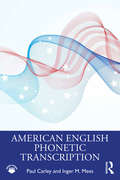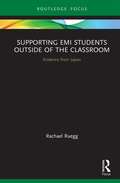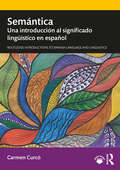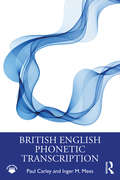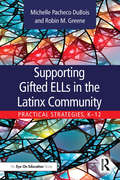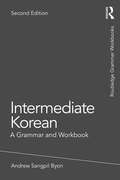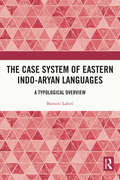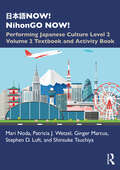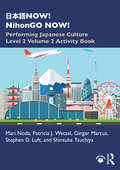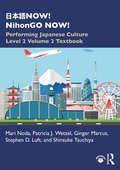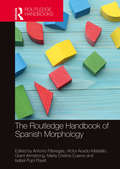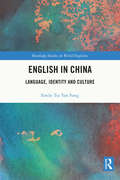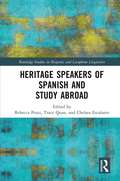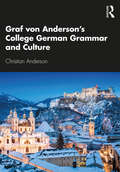- Table View
- List View
American English Phonetic Transcription
by Paul Carley Inger M. MeesAmerican English Phonetic Transcription provides an accessible introduction to phonemic, phonetic, and intonational transcription with a focus on American English. Featuring exercises, revision tasks, and recordings to help students gain hands-on practice, the book takes a learning-by-doing approach and ensures students gain practice using each new symbol or concept introduced before moving on to the next. Consisting of three parts, the book covers: transcribing individual words, including consonants, vowels, primary stress, secondary stress, syllabic consonants, and inflections; transcribing phrases and sentences, including weak forms, elision, and assimilation; transcribing intonation, including the structure of English intonation and recognizing pitch patterns. Ideally suited as a standalone workbook or for use alongside British English Phonetic Transcription, American English Phonetic Transcription is key reading for undergraduate students of linguistics as well as anyone teaching or learning English as a foreign language.
Supporting EMI Students Outside of the Classroom: Evidence from Japan (Routledge Focus on English-Medium Instruction in Higher Education)
by Rachael RueggThere is a growing body of research on English-medium Instruction (EMI) in Asian contexts, and much of this research points out difficulties experienced by stakeholders. This volume takes up the issue of support for EMI, which is, and which can be, offered to students outside of the classroom in order to help them succeed academically in an EMI environment. Dr Ruegg’s book demonstrates the effectiveness of such support in the Japanese context. It begins by examining the support currently available for students in English-medium full degree programmes then goes on to examine one successful support service in more detail in order to determine the kinds of effects that can be achieved by establishing such a centre. The research reported in this book was conducted in Japan, but the findings will apply in other locations, especially in other Asian countries. The information provided in the book is expected to inform institutions who are looking to either establish an English-medium degree programme or improve on an existing programme by sharing information about the practices of other institutions.
Supporting EMI Students Outside of the Classroom: Evidence from Japan (Routledge Focus on English-Medium Instruction in Higher Education)
by Rachael RueggThere is a growing body of research on English-medium Instruction (EMI) in Asian contexts, and much of this research points out difficulties experienced by stakeholders. This volume takes up the issue of support for EMI, which is, and which can be, offered to students outside of the classroom in order to help them succeed academically in an EMI environment. Dr Ruegg’s book demonstrates the effectiveness of such support in the Japanese context. It begins by examining the support currently available for students in English-medium full degree programmes then goes on to examine one successful support service in more detail in order to determine the kinds of effects that can be achieved by establishing such a centre. The research reported in this book was conducted in Japan, but the findings will apply in other locations, especially in other Asian countries. The information provided in the book is expected to inform institutions who are looking to either establish an English-medium degree programme or improve on an existing programme by sharing information about the practices of other institutions.
Semántica: Una introducción al significado lingüístico en español
by Carmen CurcóSemántica: Una introducción al significado lingüístico en español es una introducción integral al estudio de la semántica con un enfoque especial en la lengua española. Sin asumir conocimientos lingüísticos previos, el libro conduce al lector por los principales temas del estudio del significado, logrando un equilibrio entre la teoría y la práctica. Los temas nocionales y las discusiones conceptuales se entrelazan con el desarrollo de herramientas analíticas. Las explicaciones se apoyan en abundantes ejemplos que ilustran los puntos tratados. Cada capítulo proporciona ejercicios y sugerencias para lecturas e investigaciones adicionales con el fin de guiar a los estudiantes de español en las complejidades de la semántica léxica y composicional. Escrito íntegramente en español en un estilo claro y atractivo, el libro es ideal para estudiantes avanzados de pregrado y posgrado de español y lingüística hispánica. Semántica: Una introducción al significado lingüístico en español is a comprehensive introduction to the study of semantics with a special focus on Spanish. Without assuming prior linguistic knowledge, the book leads the reader through the main topics in the study of meaning, striking a balance between theory and practice. In a clear and engaging style, notional issues and conceptual discussions are intertwined with the development of analytical tools. Explanations are supported by plentiful examples to reinforce each new point. Exercises and suggestions for further reading and research are provided throughout to guide students of Spanish seamlessly into the complexities of lexical and compositional semantics. Written entirely in Spanish, the book is ideal for advanced undergraduate and graduate students of Spanish and Spanish linguistics.
Semántica: Una introducción al significado lingüístico en español
by Carmen CurcóSemántica: Una introducción al significado lingüístico en español es una introducción integral al estudio de la semántica con un enfoque especial en la lengua española. Sin asumir conocimientos lingüísticos previos, el libro conduce al lector por los principales temas del estudio del significado, logrando un equilibrio entre la teoría y la práctica. Los temas nocionales y las discusiones conceptuales se entrelazan con el desarrollo de herramientas analíticas. Las explicaciones se apoyan en abundantes ejemplos que ilustran los puntos tratados. Cada capítulo proporciona ejercicios y sugerencias para lecturas e investigaciones adicionales con el fin de guiar a los estudiantes de español en las complejidades de la semántica léxica y composicional. Escrito íntegramente en español en un estilo claro y atractivo, el libro es ideal para estudiantes avanzados de pregrado y posgrado de español y lingüística hispánica. Semántica: Una introducción al significado lingüístico en español is a comprehensive introduction to the study of semantics with a special focus on Spanish. Without assuming prior linguistic knowledge, the book leads the reader through the main topics in the study of meaning, striking a balance between theory and practice. In a clear and engaging style, notional issues and conceptual discussions are intertwined with the development of analytical tools. Explanations are supported by plentiful examples to reinforce each new point. Exercises and suggestions for further reading and research are provided throughout to guide students of Spanish seamlessly into the complexities of lexical and compositional semantics. Written entirely in Spanish, the book is ideal for advanced undergraduate and graduate students of Spanish and Spanish linguistics.
British English Phonetic Transcription
by Paul Carley Inger M. MeesBritish English Phonetic Transcription provides an accessible introduction to phonemic, phonetic and intonational transcription with a focus on British English. Featuring exercises, revision tasks and recordings to help students gain hands-on practice, the book takes a learning-by-doing approach and ensures students gain practice using each new symbol or concept introduced before moving on to the next. Consisting of three parts, the book covers: transcribing individual words, including consonants, vowels, primary stress, secondary stress, syllabic consonants and inflections; transcribing phrases and sentences, including liaison, weak forms, elision and assimilation; transcribing intonation, including the structure of English intonation and recognising pitch patterns. Ideally suited as a standalone workbook or for use alongside American English Phonetic Transcription, British English Phonetic Transcription is key reading for undergraduate students of linguistics as well as anyone teaching or learning English as a foreign language.
British English Phonetic Transcription
by Paul Carley Inger M. MeesBritish English Phonetic Transcription provides an accessible introduction to phonemic, phonetic and intonational transcription with a focus on British English. Featuring exercises, revision tasks and recordings to help students gain hands-on practice, the book takes a learning-by-doing approach and ensures students gain practice using each new symbol or concept introduced before moving on to the next. Consisting of three parts, the book covers: transcribing individual words, including consonants, vowels, primary stress, secondary stress, syllabic consonants and inflections; transcribing phrases and sentences, including liaison, weak forms, elision and assimilation; transcribing intonation, including the structure of English intonation and recognising pitch patterns. Ideally suited as a standalone workbook or for use alongside American English Phonetic Transcription, British English Phonetic Transcription is key reading for undergraduate students of linguistics as well as anyone teaching or learning English as a foreign language.
Supporting Gifted ELLs in the Latinx Community: Practical Strategies, K-12
by Michelle Pacheco DuBois Robin M. GreeneThis essential resource is designed to help your classroom, school, or district better identify and serve gifted English language learners in the Latinx community. Drawing on detailed case studies and vignettes from actual programs, chapters highlight the unique needs of gifted Latinx English language learners, and look at how you can best identify and support their development. Covering topics from teacher bias and systemic racism to best practices for engaging families and communities, this book lays out practical strategies and an accessible framework for implementing culturally responsive assessments, identification, and programming strategies.
Supporting Gifted ELLs in the Latinx Community: Practical Strategies, K-12
by Michelle Pacheco DuBois Robin M. GreeneThis essential resource is designed to help your classroom, school, or district better identify and serve gifted English language learners in the Latinx community. Drawing on detailed case studies and vignettes from actual programs, chapters highlight the unique needs of gifted Latinx English language learners, and look at how you can best identify and support their development. Covering topics from teacher bias and systemic racism to best practices for engaging families and communities, this book lays out practical strategies and an accessible framework for implementing culturally responsive assessments, identification, and programming strategies.
Intermediate Korean: A Grammar and Workbook (Routledge Grammar Workbooks)
by Andrew Sangpil ByonThis revised second edition of Intermediate Korean: A Grammar and Workbook is an accessible reference grammar and related exercises in a single volume. The text can be used in conjunction with any primary textbook, both as a reference guide to the intermediate Korean grammar and a practice book to reinforce learning. This book presents 24 individual grammar points, covering the core material that students would expect to encounter in their second year of learning Korean. Grammar points are followed by examples and exercises which allow students to reinforce and consolidate their learning. Key features include: Clear, accessible format Many useful language examples All Korean entries presented in Hangul with English translations Abundant exercises with full answer key Subject index. Clearly presented and user-friendly, Intermediate Korean provides readers with the essential tools to express themselves in a wide variety of situations, making it an ideal grammar reference and practice resource for students with some knowledge of the language. Intermediate Korean is suitable for both class use as well as independent study.
Intermediate Korean: A Grammar and Workbook (Routledge Grammar Workbooks)
by Andrew Sangpil ByonThis revised second edition of Intermediate Korean: A Grammar and Workbook is an accessible reference grammar and related exercises in a single volume. The text can be used in conjunction with any primary textbook, both as a reference guide to the intermediate Korean grammar and a practice book to reinforce learning. This book presents 24 individual grammar points, covering the core material that students would expect to encounter in their second year of learning Korean. Grammar points are followed by examples and exercises which allow students to reinforce and consolidate their learning. Key features include: Clear, accessible format Many useful language examples All Korean entries presented in Hangul with English translations Abundant exercises with full answer key Subject index. Clearly presented and user-friendly, Intermediate Korean provides readers with the essential tools to express themselves in a wide variety of situations, making it an ideal grammar reference and practice resource for students with some knowledge of the language. Intermediate Korean is suitable for both class use as well as independent study.
The Case System of Eastern Indo-Aryan Languages: A Typological Overview
by Bornini LahiriThis book presents a typological overview of the case system of Eastern Indo-Aryan (EIA) languages. It utilises a cognitive framework to analyse and compare the case markers of seven EIA languages, namely Angika, Asamiya, Bhojpuri, Bangla, Magahi, Maithili and Odia. The book introduces semantic maps, which had hitherto not been used for Indian languages, to plot the scope of different case markers and facilitate cross-linguistic comparison of these languages. It also offers a detailed questionnaire specially designed for fieldwork and data collection which will be extremely useful to researchers involved in the study of ‘case’. A unique look into the linguistic traditions of South Asia, the book will be indispensable to academicians, researchers, and students of language studies, linguistics, literature, cognitive science, psychology, language technologies and South Asian studies. It will also be useful for linguists, typologists, grammarians and those interested in the study of Indian languages.
The Case System of Eastern Indo-Aryan Languages: A Typological Overview
by Bornini LahiriThis book presents a typological overview of the case system of Eastern Indo-Aryan (EIA) languages. It utilises a cognitive framework to analyse and compare the case markers of seven EIA languages, namely Angika, Asamiya, Bhojpuri, Bangla, Magahi, Maithili and Odia. The book introduces semantic maps, which had hitherto not been used for Indian languages, to plot the scope of different case markers and facilitate cross-linguistic comparison of these languages. It also offers a detailed questionnaire specially designed for fieldwork and data collection which will be extremely useful to researchers involved in the study of ‘case’. A unique look into the linguistic traditions of South Asia, the book will be indispensable to academicians, researchers, and students of language studies, linguistics, literature, cognitive science, psychology, language technologies and South Asian studies. It will also be useful for linguists, typologists, grammarians and those interested in the study of Indian languages.
日本語NOW! NihonGO NOW!: Performing Japanese Culture – Level 2 Volume 2 Textbook and Activity Book
by Mari Noda Patricia J. Wetzel Ginger Marcus Stephen D. Luft Shinsuke TsuchiyaNihonGO NOW! Level 2 is an intermediate level courseware package that takes a performed-culture approach to learning Japanese. This approach balances the need for an intellectual understanding of structural elements with multiple opportunities to experience the language within its cultural context. From the outset, learners are presented with samples of authentic language that are context-sensitive and culturally coherent. Instructional time is used primarily to rehearse interactions that learners of Japanese are likely to encounter in the future, whether they involve speaking, listening, writing, or reading. Level 2 comprises two textbooks with accompanying activity books. These four books in combination with audio files allow instructors to adapt an intermediate level course, such as the second or third year of college Japanese, to their students’ needs. They focus on language and modeled behavior, providing opportunities for learners to acquire language through performance templates. Online resources provide additional support for both students and instructors. Audio files, videos, supplementary exercises, and a teachers’ manual are available at www.routledge.com/9781138305304.
日本語NOW! NihonGO NOW!: Performing Japanese Culture – Level 2 Volume 2 Activity Book
by Mari Noda Patricia J. Wetzel Ginger Marcus Stephen D. Luft Shinsuke TsuchiyaNihonGO NOW! Level 2 is an intermediate-level courseware package that takes a performed-culture approach to learning Japanese. This approach balances the need for an intellectual understanding of structural elements with multiple opportunities to experience the language within its cultural context. From the outset, learners are presented with samples of authentic language that are context-sensitive and culturally coherent. Instructional time is used primarily to rehearse interactions that learners of Japanese are likely to encounter in the future, whether they involve speaking, listening, writing, or reading. Level 2 comprises two textbooks with accompanying activity books. These four books in combination with audio and video files allow instructors to adapt an intermediate-level course, such as the second or third year of college Japanese, to their students’ needs. They focus on language and modeled behavior, providing opportunities for learners to acquire language through performance templates. Online resources provide additional support for both students and instructors. Audio files, videos, supplementary exercises, and a teachers’ manual are available at www.routledge.com/9781138305304. NihonGO NOW! Level 2 Volume 2 Activity Book provides a wealth of communicative exercises for students following the Level 2 Volume 2 Textbook.
日本語NOW! NihonGO NOW!: Performing Japanese Culture – Level 2 Volume 2 Textbook
by Mari Noda Patricia J. Wetzel Ginger Marcus Stephen D. Luft Shinsuke TsuchiyaNihonGO NOW! Level 2 is an intermediate-level courseware package that takes a performed-culture approach to learning Japanese. This approach balances the need for an intellectual understanding of structural elements with multiple opportunities to experience the language within its cultural context. From the outset, learners are presented with samples of authentic language that are context-sensitive and culturally coherent. Instructional time is used primarily to rehearse interactions that learners of Japanese are likely to encounter in the future, whether they involve speaking, listening, writing, or reading. Level 2 comprises two textbooks with accompanying activity books. These four books in combination with audio and video files allow instructors to adapt an intermediate-level course, such as the second or third year of college Japanese, to their students’ needs. They focus on language and modeled behavior, providing opportunities for learners to acquire language through performance templates. Online resources provide additional support for both students and instructors. Audio files, videos, supplementary exercises, and a teachers’ manual are available at www.routledge.com/9781138305304. NihonGO NOW! Level 2 Volume 2 Textbook is ideally accompanied by the Level 2 Volume 2 Activity Book.
日本語NOW! NihonGO NOW!: Performing Japanese Culture - Level 2 Volume 1 Textbook and Activity Book
by Mari Noda Patricia J. Wetzel Ginger Marcus Stephen D. Luft Shinsuke TsuchiyaNihonGO NOW! Level 2 is an intermediate level courseware package that takes a performed-culture approach to learning Japanese. This approach balances the need for an intellectual understanding of structural elements with multiple opportunities to experience the language within its cultural context. From the outset, learners are presented with samples of authentic language that are context-sensitive and culturally coherent. Instructional time is used primarily to rehearse interactions that learners of Japanese are likely to encounter in the future, whether they involve speaking, listening, writing, or reading. Level 2 comprises two textbooks with accompanying activity books. These four books in combination with audio files allow instructors to adapt an intermediate level course, such as the second or third year of college Japanese, to their students’ needs. They focus on language and modeled behavior, providing opportunities for learners to acquire language through performance templates. Online resources provide additional support for both students and instructors. Audio files, videos, supplementary exercises, and a teachers’ manual are available at www.routledge.com/9781138305304.
The Routledge Handbook of Spanish Morphology (Routledge Spanish Language Handbooks)
by Antonio FábregasThe Routledge Handbook of Spanish Morphology presents a state-of-the-art, detailed and exhaustive overview of all aspects of Spanish morphology, paying equal attention to the empirical complexities of the morphological system and the theoretical issues that they raise. As such, this handbook is relevant both for those interested in the facts of Spanish morphology and those interested in general morphology that want to explore how the Spanish facts illuminate our understanding of human language and current theories of morphology. This volume is also unique in its extent and coverage. Written by an international team of leading experts in the field, it contains 42 chapters divided into four sections, covering all synchronic and diachronic aspects of Spanish morphology, including inflection; derivation; compounding and other processes of word formation; the interaction of morphology with other modules of grammar and the role of morphology in language acquisition, psycholinguistics and language teaching.
The Routledge Handbook of Spanish Morphology (Routledge Spanish Language Handbooks)
by Antonio Fábregas Víctor Acedo-Matellán Grant Armstrong María Cristina Cuervo Isabel Pujol PayetThe Routledge Handbook of Spanish Morphology presents a state-of-the-art, detailed and exhaustive overview of all aspects of Spanish morphology, paying equal attention to the empirical complexities of the morphological system and the theoretical issues that they raise. As such, this handbook is relevant both for those interested in the facts of Spanish morphology and those interested in general morphology that want to explore how the Spanish facts illuminate our understanding of human language and current theories of morphology. This volume is also unique in its extent and coverage. Written by an international team of leading experts in the field, it contains 42 chapters divided into four sections, covering all synchronic and diachronic aspects of Spanish morphology, including inflection; derivation; compounding and other processes of word formation; the interaction of morphology with other modules of grammar and the role of morphology in language acquisition, psycholinguistics and language teaching.
English in China: Language, Identity and Culture (Routledge Studies in World Englishes)
by Emily Tsz FongThis volume explores Chinese identity through the lens of both the Chinese and English languages. Until the twentieth century, English was a language associated with capitalists and "military aggressors" in China. However, the massive progression of globalisation in China following the 1980s has transformed the language into an important tool for China’s modernisation. Regardless of the role English plays in China, there has always been a fear there that the spread of culture(s) associated with English would lead to weakening of the Chinese identity. This fear resulted in the development of the ti-yong principle: "Chinese learning for essence (ti), Western learning for utility (yong)." Fong’s book aims to enhance understanding of the ti-yong dichotomy in relation to people’s sense of being Chinese in China, the penetration of English into non-English speaking societies, the resultant tensions in people’s sense of personal and national identity, and their place in the world. Using Q methodology, the book presents observations based on data collected from four participant groups, namely high school and university students, teachers and parents in China, to investigate their perspectives on the status and roles of English, as well as those of Chinese. Considering the growing international interest in China, this volume will appeal to readers interested in China’s contemporary society in general, its language, culture and identity. It will be a useful resource for academics, researchers and students in the field of applied linguistics, language education and Chinese cultural studies and can also be adopted as a reference book for undergraduate courses relating to language, identity and culture.
English in China: Language, Identity and Culture (Routledge Studies in World Englishes)
by Emily Tsz FongThis volume explores Chinese identity through the lens of both the Chinese and English languages. Until the twentieth century, English was a language associated with capitalists and "military aggressors" in China. However, the massive progression of globalisation in China following the 1980s has transformed the language into an important tool for China’s modernisation. Regardless of the role English plays in China, there has always been a fear there that the spread of culture(s) associated with English would lead to weakening of the Chinese identity. This fear resulted in the development of the ti-yong principle: "Chinese learning for essence (ti), Western learning for utility (yong)." Fong’s book aims to enhance understanding of the ti-yong dichotomy in relation to people’s sense of being Chinese in China, the penetration of English into non-English speaking societies, the resultant tensions in people’s sense of personal and national identity, and their place in the world. Using Q methodology, the book presents observations based on data collected from four participant groups, namely high school and university students, teachers and parents in China, to investigate their perspectives on the status and roles of English, as well as those of Chinese. Considering the growing international interest in China, this volume will appeal to readers interested in China’s contemporary society in general, its language, culture and identity. It will be a useful resource for academics, researchers and students in the field of applied linguistics, language education and Chinese cultural studies and can also be adopted as a reference book for undergraduate courses relating to language, identity and culture.
Heritage Speakers of Spanish and Study Abroad (Routledge Studies in Hispanic and Lusophone Linguistics)
by Rebecca PozziHeritage Speakers of Spanish and Study Abroad is an edited volume that provides emerging research on heritage speakers of Spanish in immersion contexts in theoretical, empirical, and programmatic terms. This edited collection seeks to expand our understanding of heritage speakers of Spanish by incorporating research on their linguistic, sociolinguistic, and pragmatic development during and after a sojourn abroad, by discussing the complexities of their identity formation and negotiation during immersive stays, and by highlighting programmatic innovations that could be leveraged to better serve diverse learners in study abroad contexts. This volume advances the fields of both heritage language education and research on immersion study in a variety of ways, and will be of interest to scholars of applied linguistics, sociolinguistics, second language acquisition, and educational linguistics, especially those interested in study abroad programming and Spanish for heritage speakers.
Heritage Speakers of Spanish and Study Abroad (Routledge Studies in Hispanic and Lusophone Linguistics)
by Rebecca Pozzi Tracy Quan Chelsea EscalanteHeritage Speakers of Spanish and Study Abroad is an edited volume that provides emerging research on heritage speakers of Spanish in immersion contexts in theoretical, empirical, and programmatic terms. This edited collection seeks to expand our understanding of heritage speakers of Spanish by incorporating research on their linguistic, sociolinguistic, and pragmatic development during and after a sojourn abroad, by discussing the complexities of their identity formation and negotiation during immersive stays, and by highlighting programmatic innovations that could be leveraged to better serve diverse learners in study abroad contexts. This volume advances the fields of both heritage language education and research on immersion study in a variety of ways, and will be of interest to scholars of applied linguistics, sociolinguistics, second language acquisition, and educational linguistics, especially those interested in study abroad programming and Spanish for heritage speakers.
Graf von Anderson's College German Grammar and Culture
by Christian AndersonGraf von Anderson’s College German Grammar and Culture is a beginners’ textbook (CEFR A1-B2, ACTFL novice low – intermediate low) for the German language for college students and for those engaged in self-study with popular software programs and apps. In addition to illuminating profiles of key places and individuals who helped shape German history from Roman times to the present day, the textbook also includes important cultural briefings. Chapter by chapter the book delineates the scope of the German language, beginning with “ich”, and moving on to subjects and verbs. Later chapters introduce cases, indirect and direct objects, prepositions, tenses, moods, and adjectives. Each chapter includes challenging exercises, and an answer key is provided. The rich cultural component in each chapter includes a travel guide, a historical snapshot, several musical selections, and a German text to read. This book is a straightforward and thorough introduction to the basic structures of German grammar and provides an overview of selected highlights of German culture to engage and enthuse.
Graf von Anderson's College German Grammar and Culture
by Christian AndersonGraf von Anderson’s College German Grammar and Culture is a beginners’ textbook (CEFR A1-B2, ACTFL novice low – intermediate low) for the German language for college students and for those engaged in self-study with popular software programs and apps. In addition to illuminating profiles of key places and individuals who helped shape German history from Roman times to the present day, the textbook also includes important cultural briefings. Chapter by chapter the book delineates the scope of the German language, beginning with “ich”, and moving on to subjects and verbs. Later chapters introduce cases, indirect and direct objects, prepositions, tenses, moods, and adjectives. Each chapter includes challenging exercises, and an answer key is provided. The rich cultural component in each chapter includes a travel guide, a historical snapshot, several musical selections, and a German text to read. This book is a straightforward and thorough introduction to the basic structures of German grammar and provides an overview of selected highlights of German culture to engage and enthuse.
